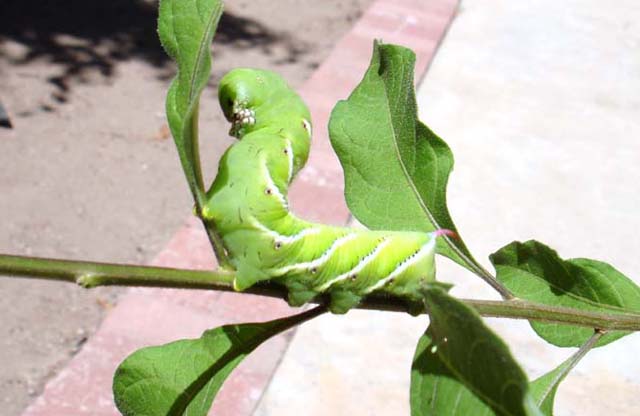Sphingidae Larval Checklist
Orange County, California

Manduca sexta, August 17, 2007,
southern Orange County, California,
courtesy of Jessica Cera
|
|
Created/dedicated as per personal communication with Jessica Cera, August 17, 2007 Updated as per James P. Tuttle's The Hawk Moths of North America, September 25, 2009 Updated as per personal communication with Chuck Knight, (Manduca sexta larva), Placentia, September 25, 2009, September 7, 2013 Updated as per personal communication with Monika Burke (Smerinthus saliceti (adult moth), San Clemente, August 4, 2016); August 5, 2016 |

For care of "found larvae/caterpillars" visit Manduca sexta larva, central Texas, August 21, 2008, Trina Woodall.
It is hoped that this checklist, with the thumbnails and notes, will help you quickly identify the Sphingidae larvae you have encountered.
A WO" after the species name indicates that I have no confirmed reports of this species in Orange County, but I (William Oehlke) expect that this moth is present.
A USGS indicates the moth is reported on the USGS website and/or in Moths of Western North America, #2. Distribution of Sphingidae of Western North America, revised, an excellent little booklet available through Paul Opler.
This page is inspired by and dedicated to Jessica Cera who sent me the image of the Manduca sexta larva at the top of the page.
Jessica writes, "I was looking to identify this caterpillar I found and happened to find your website!
"I'm guessing that it is the tobacco hornworm larva (Manduca sexta), seen today, Aug 17, 2007, in Southern Orange County, California."
Visit Orange County Sphingidae Moths.
Visit California Catocala: Underwing Moths
Sphinginae subfamily
Smerinthini Tribe:
Macroglossinae subfamilyDilophonotini Tribe:
Philampelini Tribe:
Macroglossini Tribe:
|
Enjoy some of nature's wonderments, giant silk moth cocoons. These cocoons are for sale winter and fall. Beautiful Saturniidae moths will emerge the following spring and summer. Read Actias luna rearing article. Additional online help available.
Use your browser "Back" button to return to the previous page.
This page is brought to you by Bill Oehlke and the WLSS. Pages are on space rented from Bizland. If you would like to become a "Patron of the Sphingidae Site", contact Bill.
Please send sightings/images to Bill. I will do my best to respond to requests for identification help.
 Show appreciation for this site by clicking on flashing butterfly to the left. The link will take you to a page with links to many insect sites. |
I very much appreciate all the many images that have been sent to me, or of which I have been granted permission to copy and post from other websites. All images on this site remain the property of respective photographers.
If you would like to contribute to the maintenace of this website by sending a contribution to
Bill Oehlke
Box 476
155 Peardon Road
Montague, Prince Edward Island, C0A1R0
Canada
your donation would be much appreciated and would be used for
1) paying for webspace rental;
2) paying for computer maintenance and software upgrades;
3) purchases of additional text reference material (journals and books) in anticipation of expanding the site to a worldwide Sphingidae site;
4) helping to pay my daughter's tuition (completed spring 2013); with anything left over going to humanitarian aid.
If you are mailing a check from USA, please use $1.10 postage (2013 rate); $1.25 (2015 rate). Donations can also be made through Paypal via the button below.